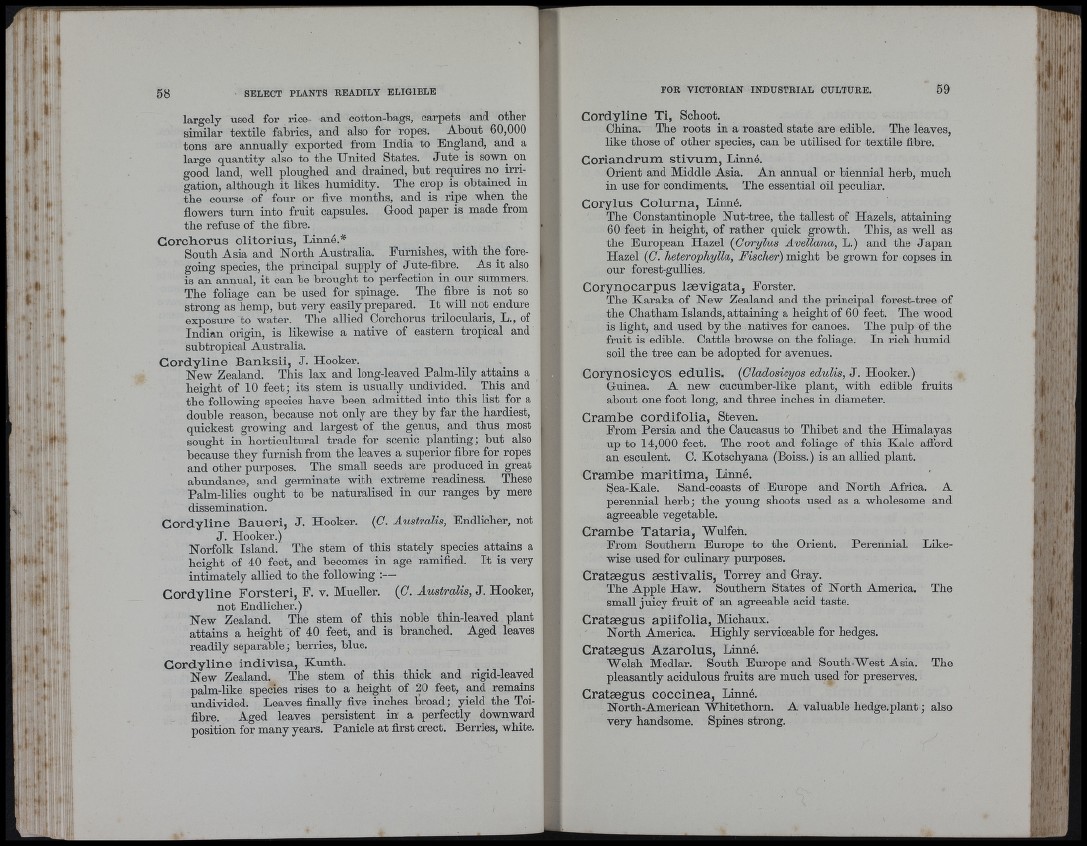
t ; I (î í .
! Hr■i
, !
58 SELECT PLANTS READILY ELIGIBLE
I ’
ll
I.
. tl*
largely used for rice- and cotton-bags, carpets and other
similar textile fabrics, and also for ropes. About 60,000
tons are annually exported from India to England, and a
large quantity also to the United States. Ju te is sown on
good land, well ploughed and drained, but requires no irrigation,
although it likes humidity. The crop is obtained in
tbe course of four or five months, and is ripe when the
fiowers turn into fruit capsules. Good paper is made from
the refuse of the fibre.
Corchorus olitorius, Lùmé.*
South Asia and North Australia. Furnishes, with the foregoing
species, the principal supply of Jute-fibre. As it also
is an annual, it can be brought to perfection in our summers.
The foliage can be used for spinage. The fibre is not so
strong as liemp, but very easily prepared. I t will not endure
exposure to water. The allied Corchorus trilocularis, L., of
Indian origin, is likewise a native of eastern tropical and
subtropical Australia.
Cordyline Banksii, J. Hooker.
New Zealand. This lax and long-leaved Palm-lily attains a
height of 10 feet; its stem is usually undivided._ This and
the following species bave been admitted into this list for a
double reason, because not only are they by far tbe hardiest,
quickest growing and largest of the genus, and thus most
sought in horticultural trade for scenic planting; but also
because they furnish from tbe leaves a superior fibre for ropes
and other purposes. The small seeds are produced in great
abundance, and germinate with extreme readiness. These
Palm-lilies ought to be naturalised in our ranges by mere
dissemination.
Cordyline Baueri, J . Hooker. (C. Australis, Endlicher, not
J . Hooker.)
Norfolk Island. The stem of this stately species attains a
height of 40 feet, and becomes in age ramified. I t is very
intimately allied to the following :—
Cordyline Forsteri, E. v. Mueller. (C. Australis, J . Hooker,
not Endlicher.)
New Zealand. The stem of this noble thin-leaved plant
attains a height of 40 feet, and is branched. Aged leaves
readily separable; berries, blue.
Cordyline indivisa, Kuntb.
New Zealand. The stem of this thick and rigid-leaved
palm-like species rises to a height of 20 feet, and remains
undivided. Leaves finally five inches broad; yield the Toi-
fibre. Aged leaves persistent in a perfectly downward
position for many years. Panicle at first erect. Berries, white.
FOR VICTORIAN INDUSTRIAL CULTURE. 59
Cordyline Ti, Schoot.
China. The roots in a roasted state are edible. Tbe leaves,
like those of other species, can be utilised for textile fibre.
Coriandrum stivum, Linné.
Orient and Middle Asia. An annual or biennial herb, much
in use for condiments. The essential oil peculiar.
Corylus Colurna, Linné.
The Constantinople Nut-tree, the tallest of Hazels, attaining
60 feet in height, of rather quick growth. This, as well as
the European Hazel {Corylus Avellana, L.) and the Japan
Hazel {C. heterophylla, Fischer) might be grown for copses in
onr forest-gullies.
Corynocarpus lævigata, Forster.
The Karaka of New Zealand and the principal forest-tree of
the Chatham Islands, attaining a height of 60 feet. The wood
is light, and used by tbe natives for canoes. Tbe pulp of the
fruit is edible. Cattle browse on the foliage. In rich humid
soil the tree can be adopted for avenues.
Corynosicyos edulis. {Cladosicyos edulis, J . Hooker.)
Guinea. A new cucnmber-like plant, with edible fruits
about one foot long, and three inches in diameter.
Crambe cordifolia, Steven.
From Persia and the Caucasus to Thibet and tbe Himalayas
up to 14,000 feet. The root and foliage of this Kale afibrd
an esculent. C. Kotschyana (Boiss.) is an allied plant.
Crambe marítima, Linné.
Sea-Kale. Sand-coasts of Europe and North Africa. A
perennial herb; the yoimg shoots used as a wholesome and
agreeable vegetable.
Crambe Tataria, Wulfen.
From Southern Europe to tbe Orient. Perennial. Likewise
used for culinary purposes.
Cratægus æstivalis, Torrey and Gray.
The Apple Haw. Southern States of North America. The
small juicy fruit of an agreeable acid taste.
Cratægus apiifolia, Michaux.
North America. Highly serviceable for hedges.
Cratægus Azarolus, Linné.
Welsh Medlar. South Europe and South-West Asia. The
pleasantly acidulous fruits are much used for preserves.
Cratægus coccínea, Linné.
North-American Whitethorn. A valuable hedge, plant ; also
very handsome. Spines strong.
V
A M
M
i':: Ï
'k.Á
Í1,1Í.'?